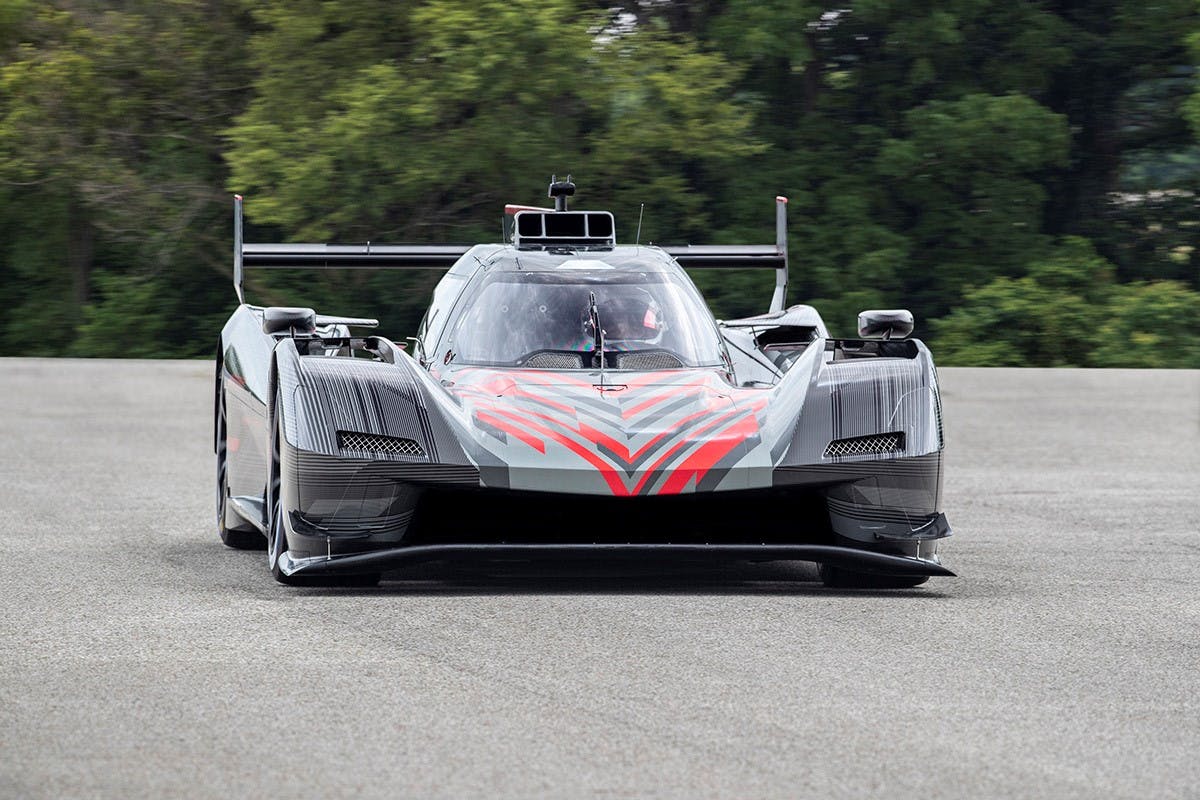A $10M four-pot Ferrari? Cadillac’s LMDh prototype hits the track, Volvo’s three-point seatbelt turns 60
This rare, four-cylinder Ferrari could fetch $10 million
Intake: The words “Testa Rossa” conjure up visions of 12 cylinder Ferraris, their double cam covers resplendent in red, but one of the earliest models to wear a TR badge actually made do with just four pots. The 500 TRC Spider of 1956–57 was related to the original 500 TR, but under the hood it had a Aurelio Lampredi-designed two-liter motor with twin Weber 40 DCOA/3 carburetors good for 190 prancing horsepower. Built for the FIA’s Appendix C rules, the Scaglietti-bodied TRC took class wins at the 24 Hours of Le Mans, the Mille Miglia, the 12 Hours of Sebring, and the Nürburgring 1000km. Just 19 units were built for privateer racers, and this 1957 example was first campaigned by Frenchman François Picard who had it painted blue and scored several class wins, including a fifth-placed finish at the Portuguese Grand Prix. The TRC was then sold to Connecticut’s Mike Garber who put Gaston Andrey behind the wheel for a series of events ranging from the Nassau Bahamas Speed Week to the 12 Hours of Sebring. Andrey won the SCCA E-Modified championships with the Ferrari in 1958 and 1959. After spending some time at a racing school, where the engine was swapped for a Ford 289 V-8, the car was sold to a collector in England who reunited the TRC with its original engine once again. Fully restored and refit with its Ferrari motor, the TRC is estimated to fetch $8-10 million at RM Sotheby’s Monterey sale on August 18–20.
Exhaust: In its day the TRC’s high-revving four-cylinder was more than a match for 12-cylinder rivals. Carrying less weight and revving into the stratosphere it was especially competitive on shorter, twistier circuits. “Simply awe-inspiring in its menacing red-over-black Scaglietti coachwork, this striking 500 TRC would make a great entrant at significant marque events or may be enjoyed at vintage racing gatherings like the Mille Miglia Storica, Le Mans Classic, or the Monterey Historics,” says Sotheby’s. Wouldn’t it be epic to see this TRC on track again? —Nik Berg
Twitter, Elon Musk headed for courtroom as Musk scraps purchase deal

Intake: Popular social media app Twitter is threatening legal action against Tesla CEO Elon Musk after he announced over the weekend that he’s scrapping his $44-billion takeover deal, according to Reuters. Musk claimed that Twitter did not disclose sufficient information on the bots and spam accounts that inhabit the platform, one, he says, of a host of breaches in the merger agreement. The suit could arrive as early as this week, and Reuters reports that legal experts feel the company has a strong case to make against Musk. In an ironic twist, Musk took to Twitter this morning trolling the company with memes related to the potential court dates. While there is a clause in the contract that calls for Musk to pay Twitter a $1 billion fee if he cannot uphold the deal through reasons such as financing falling through or regulators blocking the deal, such a fee would not be applicable if Musk terminated the deal on his own—which now appears to be his intent.
Exhaust:While Musk claims he’s scrapping the deal because of breaches of contract, others speculate that the tumultuous stock market might also play a part here. “We believe that Elon Musk’s intentions to terminate the merger are more based on the recent market sell-off than … Twitter’s ‘failure’ to comply with his requests,” Jeffries analyst Brent Hill told Reuters. Regardless of what the real driving force is, Musk may end up on the hook for some costly legal fees if this bruhaha reaches the courts. Then again, if you’re one of the world’s richest people, even eight-figure legal fees are more of a nuisance than any sort of real calamity. —Nathan Petroelje
Shiny new Cadillac LMDh racer turns its first laps
Intake: Late last week, Cadillac Racing’s LMDh racer made its first on-track appearance at an undisclosed testing venue. This maiden voyage comes about six months before the newborn Caddy hits the track in Daytona in 2023. “The first laps are the start of an aggressive testing schedule ahead of next year,” said GM sports car racing program manager Laura Wontrop Klauser. Ensuing dates at the track and the wind tunnel are expected in the next half year, and in that time there’s plenty of fresh parts to perfect, powerplant included. The new car is Cadillac Racing’s first hybrid-powered prototype, featuring a brand new 5.5-liter DOHC V-8 mated to the LMDh hybrid system. All told the unit will make up to 680-horsepower. “It was an exhilarating feeling to jump in the car for the first time and get a sense of what the future will look like,” said tester—and current Cadillac Racing driver—Earl Bamber. “So much work has gone into the 2023 race car, and I can’t wait to see it take flight next season.”
Exhaust: For Cadillac Racing, next season will be an exercise in managing expectations for its green-horned prototype racer. While we’re expecting big things from the group next year, we know the new car has some big shoes to fill. Since 2017, the firm has been dominant in IMSA endurance racing. The proven Caddy DPi racer—which the LMDh car will replace in 2023—has amassed 27 victories, three manufacturer championships in that five-year period. The new unified rules package for IMSA and FIA not only presents a unique challenge with a novel hybrid system, but also puts them in direct competition with a duo of new manufacturers. BMW and Porsche will join Cadillac and Acura in the fight for LMDh supremacy. Cadillac also plans to campaign a car full-time in the FIA’s WEC, which means a roster of never-before-seen international tracks for the American group. If there’s any firm that can win despite the mountain of new challenges, it’s the “Standard of the World.”
60 years ago, Volvo gave three-point seatbelts to the masses

Intake: On July 10, 1962, the United States Patent Office granted Volvo engineer Nils Bohlin a patent for his three-point safety belt design. Most importantly, it was an “open patent” which meant that other manufacturers were free to use the design at no cost. The Swedish brand had already stolen a march on its competitors by using Bohlin’s design for three years, but believed that everyone should benefit from its life-saving technology, no matter what car they drive.
Exhaust: Volvo’s 60 years of car safety innovation have led to a wide range of developments, from rear-facing child seats to side-impact and whiplash protection systems. Since 2019, the Swedish safety pioneer has also shared more than 40 years of real-world accident data with other carmarkers under its E.V.A Initiative. Cheers to Swedish democracy! —Nik Berg
UK group hopes to change public policy by deflating tires and has branched out to the U.S.

Intake: A group in the UK known as the Tyre Extinguishers is taking vigilante action against climate change by deflating tires of SUVs found in densely populated urban areas. The group claims to be leaderless, and its members “are defending ourselves against climate change, air pollution, and unsafe drivers.” The action of deflating tires—and it is worth noting that the group is asking others to take part by placing a bean or other chunk of debris under the valve stem cap to let the air out—is non-destructive, but the Tyre Extinguishers also state that peaceful protest has not yet yielded the action they want. Now the tire-deflating activism is branching out worldwide, including the U.S.
Exhaust: While modern SUVs have poor emissions and fuel economy, they’re a big improvement over the vehicles of just two decades ago. That isn’t a reason to sit back and do nothing, of course, but while the Tyre Extinguishers claim to be deflating tires in order to affect policy change, it’s difficult to see how inconveniencing regular people is going accomplish that. Perhaps the group’s frustration should be aimed at those who make those policies. Targeting everyday people is misplaced aggression. —Kyle Smith











